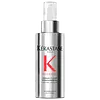What's inside
What's inside
 Benefits
Benefits

 Concerns
Concerns

 Ingredients Side-by-side
Ingredients Side-by-side

Water
Skin ConditioningIsopropyl Myristate
EmollientDimethicone
EmollientTriethanolamine
BufferingAmodimethicone
Parfum
MaskingPhenoxyethanol
PreservativeCarbomer
Emulsion StabilisingPolyquaternium-4
Potato Starch Modified
Limonene
PerfumingHydroxypropyl Guar
Emulsion StabilisingBehentrimonium Chloride
PreservativeHydrolyzed Vegetable Protein Pg-Propyl Silanetriol
Skin ConditioningGlycine
BufferingTrideceth-6
EmulsifyingIsopropyl Alcohol
SolventLinalool
PerfumingCetrimonium Chloride
AntimicrobialCitral
PerfumingCoumarin
PerfumingBenzyl Salicylate
PerfumingSodium Benzoate
MaskingBenzyl Alcohol
PerfumingCitronellol
PerfumingAlpha-Isomethyl Ionone
PerfumingPotassium Sorbate
PreservativeGeraniol
PerfumingWater, Isopropyl Myristate, Dimethicone, Triethanolamine, Amodimethicone, Parfum, Phenoxyethanol, Carbomer, Polyquaternium-4, Potato Starch Modified, Limonene, Hydroxypropyl Guar, Behentrimonium Chloride, Hydrolyzed Vegetable Protein Pg-Propyl Silanetriol, Glycine, Trideceth-6, Isopropyl Alcohol, Linalool, Cetrimonium Chloride, Citral, Coumarin, Benzyl Salicylate, Sodium Benzoate, Benzyl Alcohol, Citronellol, Alpha-Isomethyl Ionone, Potassium Sorbate, Geraniol
Hydrofluorocarbon 152a
Alcohol Denat.
AntimicrobialIsohexadecane
EmollientIsododecane
EmollientPPG-5-Ceteth-20
EmulsifyingPropylene Glycol Dibenzoate
Skin ConditioningDiisopropyl Sebacate
EmollientOctafluoropentyl Methacrylate
Isopropyl Lauroyl Sarcosinate
Skin ConditioningLinoleamidopropyl Dimethylamine Dimer Dilinoleate
Skin ConditioningHippophae Rhamnoides Fruit Oil
Skin ProtectingSimmondsia Chinensis Seed Oil
EmollientLagenaria Sphaerica Seed Oil
Skin ConditioningOrbignya Oleifera Seed Oil
EmollientMoringa Oleifera Seed Oil
EmollientOleyl Alcohol
EmollientEthylhexyl Methoxycinnamate
UV AbsorberC13-15 Alkane
SolventParfum
MaskingCitronellol
PerfumingLimonene
PerfumingCitral
PerfumingHydrofluorocarbon 152a, Alcohol Denat., Isohexadecane, Isododecane, PPG-5-Ceteth-20, Propylene Glycol Dibenzoate, Diisopropyl Sebacate, Octafluoropentyl Methacrylate, Isopropyl Lauroyl Sarcosinate, Linoleamidopropyl Dimethylamine Dimer Dilinoleate, Hippophae Rhamnoides Fruit Oil, Simmondsia Chinensis Seed Oil, Lagenaria Sphaerica Seed Oil, Orbignya Oleifera Seed Oil, Moringa Oleifera Seed Oil, Oleyl Alcohol, Ethylhexyl Methoxycinnamate, C13-15 Alkane, Parfum, Citronellol, Limonene, Citral
Ingredients Explained
These ingredients are found in both products.
Ingredients higher up in an ingredient list are typically present in a larger amount.
Citral is a fragrance and used to add a lemon-like scent to products. It is both naturally found in plants and created synthetically. In plants, it is commonly occurring in lemon myrtle, lemongrass, lemon tea-tree, lemon verbena, and other citruses.
The EU mandates Citral be listed separately as a fragrance. It is a known allergen and may cause contact dermatitis. Citral can also used as a masking ingredient.
The term 'fragrance' is not regulated in many countries. In many cases, it is up to the brand to define this term. For instance, many brands choose to label themselves as "fragrance-free" because they are not using synthetic fragrances. However, their products may still contain ingredients such as essential oils that are considered a fragrance.
The term 'citral' is a collective term for two geometric isomers: geranial/Citral A and neral/Citral B.
Learn more about CitralCitronellol is used to add fragrance/parfum to a product. It is often derived from plants such as roses. In fact, it can be found in many essential oils including geranium, lavender, neroli, and more. The scent of Citronellol is often described as "fresh, grassy, and citrus-like".
Since the Citronellol molecule is already unstable, Citronellol becomes irritating on the skin when exposed to air.
Citronellol is a modified terpene. Terpenes are unsaturated hydrocarbons found in plants. They make up the primary part of essential oils.
Citronellol is not able to be absorbed into deeper layers of the skin. It has low permeability,
Citronellol is also a natural insect repellent.
Learn more about CitronellolLimonene is a fragrance that adds scent and taste to a formulation.
It's found in the peel oil of citrus fruits and other plants such as lavender and eucalyptus. The scent of limonene is generally described as "sweet citrus".
Limonene acts as an antioxidant, meaning it helps neutralize free radicals.
When exposed to air, oxidized limonene may sensitize the skin. Because of this, limonene is often avoided by people with sensitive skin.
The term 'fragrance' is not regulated in many countries. In many cases, it is up to the brand to define this term. For instance, many brands choose to label themselves as "fragrance-free" because they are not using synthetic fragrances. However, their products may still contain ingredients such as essential oils that are considered a fragrance.
Learn more about LimoneneParfum is a catch-all term for an ingredient or more that is used to give a scent to products.
Also called "fragrance", this ingredient can be a blend of hundreds of chemicals or plant oils. This means every product with "fragrance" or "parfum" in the ingredients list is a different mixture.
For instance, Habanolide is a proprietary trade name for a specific aroma chemical. When used as a fragrance ingredient in cosmetics, most aroma chemicals fall under the broad labeling category of “FRAGRANCE” or “PARFUM” according to EU and US regulations.
The term 'parfum' or 'fragrance' is not regulated in many countries. In many cases, it is up to the brand to define this term.
For instance, many brands choose to label themselves as "fragrance-free" because they are not using synthetic fragrances. However, their products may still contain ingredients such as essential oils that are considered a fragrance by INCI standards.
One example is Calendula flower extract. Calendula is an essential oil that still imparts a scent or 'fragrance'.
Depending on the blend, the ingredients in the mixture can cause allergies and sensitivities on the skin. Some ingredients that are known EU allergens include linalool and citronellol.
Parfum can also be used to mask or cover an unpleasant scent.
The bottom line is: not all fragrances/parfum/ingredients are created equally. If you are worried about fragrances, we recommend taking a closer look at an ingredient. And of course, we always recommend speaking with a professional.
Learn more about Parfum